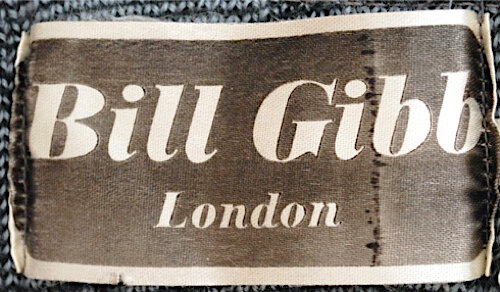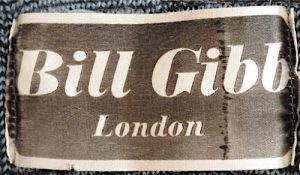Born William Elphinstone Gibb (1943-1988) near New Pitsligo, Fraserburgh, Scotland, Gibb grew up on a small dairy farm and in his youth he developed a passion for drawing. His talent was noticed by his art teacher at school in Fraserburgh and he was encouraged to move to London in 1962 to study at St. Martins School of Art. He often struggled with the making aspects of the course, as his talents were in the designing of garments and at one point he considered giving up. The Dean of St. Martins, however, had spotted his potential and encouraged him to persevere with the construction process. He eventually graduated first in his year and gained a scholarship to the Royal College of Art in 1966 under the legendary Janey Ironside. At this stage in his career it was clear from his sketchbooks and research that he had a fascination with historical dress, with both Renaissance and Byzantine styles playing a large part in this.
He failed to complete his studies at the RCA, being distracted by both his involvement with the Yardley “London Look” award in New York and a new boutique called Alice Paul in Kensington. The London Look award led to the commission of an entire collection from Gibb and he set about researching for this on a tour of America with his friend and creative partner, the painter Kaffe Fassett.
The Alice Paul boutique was started with three friends and ran from 1967-1969. Gibb provided the designs and the others provided the business and making skills. He also took on a pattern cutter called Nives Losani, who would stay with him for the rest of his career. The designs were very typical late-Sixties London style, with lots of mini skirts and maxi coats, catering to an existing market rather than attempting to be radical. He was also working for the manufacturer Baccarat between 1969 and 1972. By 1970, Gibb was being more influenced by the hippie movement which suited his love of mixing prints and experimenting with patterned knitwear. His growing popularity led to the creation of The Bill Gibb Room at Harrods in London. Twiggy even wore one of his dresses to the premiere of The Boyfriend in 1971 and the publicity this garnered had a huge impact on his blossoming career. At around the same time, he was invited by the Federation of Embroidery at Voralberg in Austria to design a collection which would represent its 21 members. Here he met Kate Franklin, who became his business partner and encouraged him to launch Bill Gibb Ltd. in 1972.
He launched with a collection in a totally new theme, using animals and nature to inspire and trim his work. Throughout his career, the clothes show a dramatic variety. He was fond of plain leathers, suedes and wool crepes, sometimes left plain but often decorated with lavish embroidery and unusual trimmings (the quirky ‘bee’ motif being his most famous). The extraordinary mixed prints in cotton contrasted with exquisite evening wear in slinky, colourful draped jerseys and shimmering, fairytale ballgowns. The shapes are voluminous and romantic, inspired by history and fantasy.
He became perhaps most famous for his extraordinary knitwear designs, undeniably inspired by his Scottish origins. Initially hand machined by Mildred Boulton, who worked from Gibb’s designs and Kaffe Fassett’s swatches, they later found a manufacturer (Harry Green of Gould’s in Leicester) who was prepared to take on the very complex designs on a larger scale. Boulton did carry on handknitting smaller-scale designs for Gibb’s label. The knitwear was one of his most successful ventures, creating countless fans of the beautifully subtle palette and extraordinary mixes of colours.
Gibb was certainly a true artist and the extraordinary creations were amongst the nearest a British designer got to haute couture. He designed with a lot of theatricality and often had to reject large numbers of designs because they were simply not saleable, which made the design process very long and drawn out for him. He was also still first and foremost a designer in ink, who relied on an army of pattern cutters and makers to transfer the designs from the page and into reality. Like so many designers of the British Boutique Movement, he often struggled with the realities of business and several times found his business on the verge of collapse. The 1980s saw him surviving by designing small capsule collections for manufacturers and creating one-off garments for faithful clients. He showed at London Fashion Week in a collaboration with Fassett in 1985, to renewed critical acclaim and it looked like his career might be on the up again. However, Gibb died of bowel cancer in 1988 before he had the opportunity to really re-establish himself in the British fashion world.
Written by emmapeelpants



